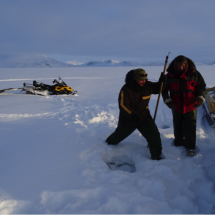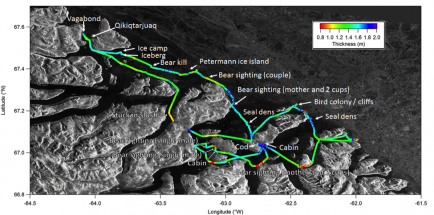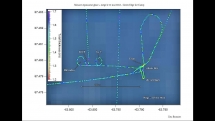Pre-camp ice and snow thickness survey
“April 20, 2016
Yesterday, Jaypootie Moesesie (Qikiqtarjuaq, GreenEdge team member), Eric Brossier (Captain of the Vagabond / GreenEdge camp manager) and I returned from a four-day, pre-icecamp ice thickness survey of the fast ice southeast of Qikiqtarjuaq. The objective of the survey was to map the variability of sea ice in the region, and to identify regions of thin ice where strong ocean currents erode the ice from underneath. Those regions are important for the ice and water ecosystem because they open up early in the melt season. They also create slush which makes over-ice travel slower and less safe.
We measured the thickness of the total, snow-plus-ice thickness with an electromagnetic (EM) thickness sounder mounted on a qamutiq, the typical Inuit sledge towed by snowmobiles. This allows to gather continuous ice thickness data, every 3-6 m along the travel route. In addition, during frequent stops, we carried out manual snow thickness measurements to quantify the contribution of snow to total ice thickness.
Results showed that there are widespread regions of thin ice less than 1 m thick, particularly between islands and in fjords. However, the region of the GreenEdge ice camp had some of the thickest ice in the study region and was found to be safe to travel. The snow was quite thick in most regions, between 35 and 50 cm due to the recent, strong snowfall.
Due to poor weather conditions my departure from Qikiqtarjuaq was delayed for several days. Lucky enough, that gave me the opportunity to welcome the first arriving members of the GreenEdge ice camp team (Marie-Helene, Joannie, and Jose), and to help set up the weather haven tent which will be the main working base for the upcoming GreenEdge bio-oceanographic water measurements at the ice camp.”
The last results of 15 May 2016 :
Dr. Christian Haas,
Canada Research Chair for Arctic Sea Ice Geophysics,
York University, Toronto,
haasc@yorku.ca





